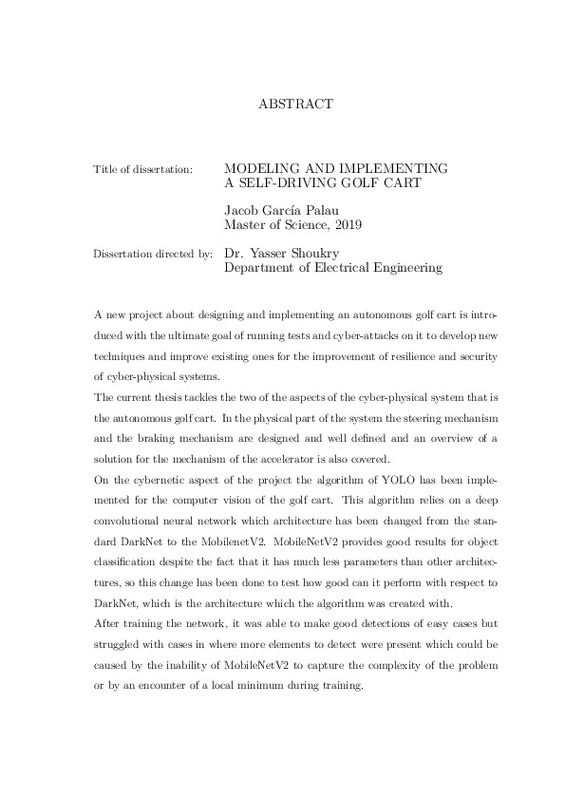JavaScript is disabled for your browser. Some features of this site may not work without it.
Buscar en RiuNet
Listar
Mi cuenta
Estadísticas
Ayuda RiuNet
Admin. UPV
Modeling and implementing a self-driving golf cart
Mostrar el registro sencillo del ítem
Ficheros en el ítem
| dc.contributor.advisor | Ramos Fernández, César
|
es_ES |
| dc.contributor.author | García Palau, Jacob
|
es_ES |
| dc.date.accessioned | 2020-05-11T11:18:27Z | |
| dc.date.available | 2020-05-11T11:18:27Z | |
| dc.date.created | 2019-07-04 | |
| dc.date.issued | 2020-05-11 | es_ES |
| dc.identifier.uri | http://hdl.handle.net/10251/142939 | |
| dc.description.abstract | [ES] Modificar un coche de golf de manera que se puedan accionar electronicamente algunos de los elementos necesarios para la conducción (volante y pedales) para habilitar la conducción sin intervención humana. También implementar un algoritmo the visión artificial para detectar elementos de la carretera. | es_ES |
| dc.description.abstract | [EN] A new project about designing and implementing an autonomous golf cart is introduced with the ultimate goal of running tests and cyber-attacks on it to develop new techniques and improve existing ones for the improvement of resilience and security of cyber-physical systems. The current thesis tackles the two of the aspects of the cyber-physical system that is the autonomous golf cart. In the physical part of the system the steering mechanism and the braking mechanism are designed and well defined and an overview of a solution for the mechanism of the accelerator is also covered. On the cybernetic aspect of the project the algorithm of YOLO has been implemented for the computer vision of the golf cart. This algorithm relies on a deep convolutional neural network which architecture has been changed from the standard DarkNet to the MobilenetV2. MobileNetV2 provides good results for object classification despite the fact that it has much less parameters than other architectures, so this change has been done to test how good can it perform with respect to DarkNet, which is the architecture which the algorithm was created with. After training the network, it was able to make good detections of easy cases but struggled with cases in where more elements to detect were present which could be caused by the inability of MobileNetV2 to capture the complexity of the problem or by an encounter of a local minimum during training. | es_ES |
| dc.language | Inglés | es_ES |
| dc.publisher | Universitat Politècnica de València | es_ES |
| dc.rights | Reconocimiento - Compartir igual (by-sa) | es_ES |
| dc.subject | Golf cart | es_ES |
| dc.subject | Visión artificial | es_ES |
| dc.subject | Conducción autónoma | es_ES |
| dc.subject | Computer vision | es_ES |
| dc.subject | Self driving | es_ES |
| dc.subject.classification | INGENIERIA DE SISTEMAS Y AUTOMATICA | es_ES |
| dc.subject.other | Máster Universitario en Ingeniería Industrial-Màster Universitari en Enginyeria Industrial | es_ES |
| dc.title | Modeling and implementing a self-driving golf cart | es_ES |
| dc.title.alternative | Diseño e implementación de coche de golf autónomo | es_ES |
| dc.type | Tesis de máster | es_ES |
| dc.rights.accessRights | Abierto | es_ES |
| dc.contributor.affiliation | Universitat Politècnica de València. Departamento de Proyectos de Ingeniería - Departament de Projectes d'Enginyeria | es_ES |
| dc.contributor.affiliation | Universitat Politècnica de València. Escuela Técnica Superior de Ingenieros Industriales - Escola Tècnica Superior d'Enginyers Industrials | es_ES |
| dc.description.bibliographicCitation | García Palau, J. (2019). Modeling and implementing a self-driving golf cart. http://hdl.handle.net/10251/142939 | es_ES |
| dc.description.accrualMethod | TFGM | es_ES |
| dc.relation.pasarela | TFGM\112901 | es_ES |
Este ítem aparece en la(s) siguiente(s) colección(ones)
-
ETSII - Trabajos académicos [9864]
Escuela Técnica Superior de Ingenieros Industriales






